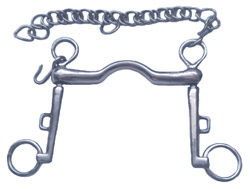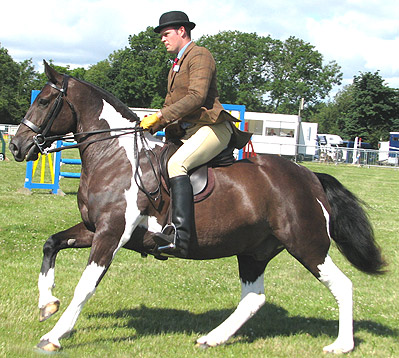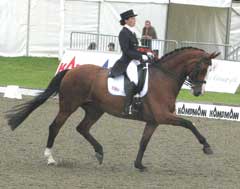
Advice About Using and Fitting a Curb Bit on a Double Bridle
In Britain Curb bits are mostly used as part of a double bridle, they are also used in Western Riding.
WHAT IS THE ACTION OF A CURB BIT ON A HORSE'S MOUTH?
 The
curb bit works by means of a leverage principle, which means that only
a light contact can produce a lot of pressure in the horse's mouth.
The
curb bit works by means of a leverage principle, which means that only
a light contact can produce a lot of pressure in the horse's mouth.
When pressure is applied to the curb rein, the cheek of the bit is pulled
backwards and the top branch moves forwards, creating a pull on the cheekpiece
attached to it and downwards pressure on the horse's poll.
It can be quite severe in the wrong hands and should only be used by a
rider with a balanced independant seat.
It is also worth remembering that the very presence of a well designed and fitted curb bit in the horse's mouth, together with a carefully fitted chain, acts as a gentle reminder to the horse of what is required of him, whether the rider uses them or not.
CHOOSING A CURB BIT TO USE WITH A DOUBLE BRIDLE
 The proportions of the curb bit, and the tightness or looseness of the
curb chain, are important factors.
The proportions of the curb bit, and the tightness or looseness of the
curb chain, are important factors.
The longer the lower cheeks of the curb the more exaggerated will be the pressure felt in the horse's mouth, and the longer the upper part of the cheek the more poll pressure there will be.
In 'olden days', cheeks of potentially jaw-breaking length were used.
As a guide, the following are considered good proportions for a curb bit: the lower branch of the bit cheek about three inches long and the upper part no more than one and a half inches long.
 If the upper part comprises
one third of the total length of the cheek (or less) and the lower two-thirds,
this is about right.
If the upper part comprises
one third of the total length of the cheek (or less) and the lower two-thirds,
this is about right.
With curb bits, it is better to buy a good quality bit which has the upper
parts of the cheeks angled slightly outwards to avoid rubbing the cheeks.
A curb can have fixed or sliding cheeks (as illustrated). A horse which is fussy in its mouth may be better with a fixed cheek curb, other horses can go better with sliding cheeks to allow then to play with the bit and have a softer mouth.
FITTING THE CURB BIT
When fitting a curb bit on a double bridle with a bridoon the mouthpiece of the curb should be slightly lower in the mouth than the bridoon.
WIDTH OF THE CURB MOUTHPIECE
The width of the mouthpiece - like the snaffle - should be such that the bit protrudes just a quarter of an inch each side of the mouth.
All mouthpieces, for any bit, are measured across the width from the inside of the cheeks or rings.
To avoid expensive mistakes when buying bits, you can measure your horse's mouth either with a piece of string, a tape measure or rigid ruler; then buy a bit just half an inch wider.
ATTACHING THE CURB CHAIN
 To attach the curb chain,
first make sure that the hooks are hanging down straight. Then take the
curb chain and straighten it out so that the links are smooth and the
little fly-link meant for the lip-strap is at the bottom.
To attach the curb chain,
first make sure that the hooks are hanging down straight. Then take the
curb chain and straighten it out so that the links are smooth and the
little fly-link meant for the lip-strap is at the bottom.
With your right thumb pointing upwards, take the chain in your right hand and slip it over the offside hook so that when it is positioned honzontally (as it will be when on both hooks) the upper part of the right-hand end link is on the inside of the hook; the chain will then ultimately lie flat.
Then, standing on the horse's near side, twist the chain clockwise till all the links are flat (this is unnecessary if you straightened it out in the first place) and the fly-link is hanging at the bottom.
Next, thumb still upwards, slot the left end link onto the nearside hook, again so it lies with its highest side upwards on the inside of the hook.
If the chain is too loose, you will need to hook on a link further down the chain - you will discover how tight it needs to be by trial and error.
Curb chains may be used with a rubber cover to be softer on the horse.
THE LENGTH AND TIGHTNESS OF THE CURB CHAIN
The actual length of the curb chain is critical to the functioning of the curb bit and its effect on the horse.
How does a curb chain work? The tighter the curb chain is the sooner and the more unmistakably the pressure is felt; and the more severe the pressure capable of being inflicted; and also the less the rider needs to use the rein.
But there are obviously limits, and the general teaching is that the chain should be adjusted so that it and the bit mouthpiece combine in their effect when the cheek of the bit forms a 45 degree angle with the line of lips - The curb and chain do not act until this angle is reached.
ATTACHING A LIP STRAP TO A CURB BIT
The use of a lip strap on a curb bit is less popular than it used to be.
The lip-strap buckles to the little ring or metal loop on the offside branch of the bit, passes through the fly-link and buckles to its other half (another separate strap) which you will have fastened to the left branch.